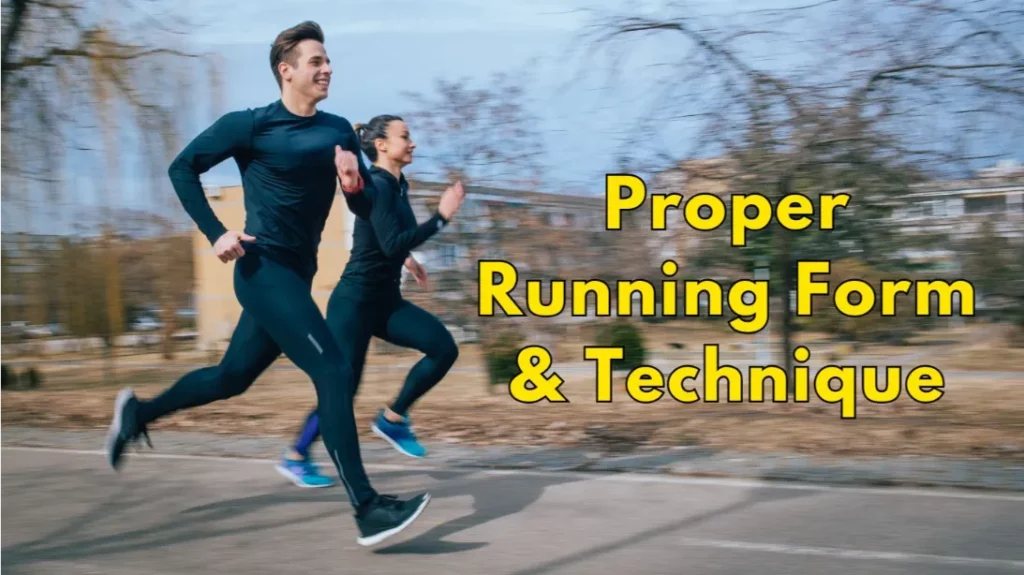Proper running form means running efficiently and safely! It’s about maintaining an upright posture, leaning slightly forward from your ankle joint, and ensuring your foot strikes land mid-foot.
Aim for a cadence of 170-190 steps per minute, swinging your arms comfortably at a 90-degree angle. Getting this correct running form down can seriously cut the risk of injury and make you a more enjoyable, healthier runner.
Key Takeaways
- Prioritize a 90-degree arm swing and upright posture to reduce energy waste Learn about posture fixes.
- Target 170–190 SPM for optimal efficiency Master cadence techniques.
- Strengthen core muscles and hips to prevent imbalances Build core strength.
Unlock Your Running Potential: The Ultimate Guide to Mastering Running Form

Whether you’re pulling on your best running shoes for the very first time or you’re an experienced marathoner looking to shave off some time, fine-tuning your running form is a game-changer.
It boosts your performance, helps with injury prevention, and makes running a whole lot more enjoyable. This guide is designed to equip recreational runners (and distance runners!) with the knowledge and practical running technique tips they need to excel.
Building Your Foundation: Posture and Body Alignment
Achieving proper running form really starts with Upright posture and optimal body in alignment. Think of it as building a house – you need a solid foundation!
- Head: Imagine a string gently lifting you from the crown of your head. This promotes good head posture. Keep your gaze forward, not down at your feet land.
- Shoulders: relaxed posture is key! Keep them loose and level, allowing for a natural arm swing. Avoid hunching or tensing your upper body.
- Core: Your core muscles are your secret weapon! Engage your abdominal muscles to stabilize your torso. This prevents excessive lateral movement and helps you maintain body balance. A strong core is incredibly vital for stability.
- Hips: Aim for a neutral position in your pelvis. Avoid overly arching your back, which can lead to lower back pain Fix anterior tilt.
- Ankles: This is where the magic happens! A slight ankle lean forward, not from your hips, is what you’re aiming for. This engages glutes effectively Strengthen posterior chain. This also helps prevent ankle injuries. This engages your glutes and promotes forward motion without restriction.
Visual Aid: Imagine a side view of a runner with a straight line extending from their ear, shoulder, hip, all the way down to the ankle intersection. An arrow illustrates that gentle lean initiating from the ankles.
Powering Your Run: Arm Swing and Cadence

Your arms and legs work in harmony. Optimizing your arm swing and running cadence improves your efficiency and saves valuable energy per stride.
- Arm Swing: Bend your arms at a 90-degree angle. Swing them forward and back (not across your body!) and keep your hands relaxed, as if you’re holding a delicate butterfly. This promotes momentum and body control. It also keeps your arms swings natural.
- Visual Aid: An animation shows the ideal arm swing motion. Note the 90-degree angle and the hands relaxed.
- Cadence: Your step rate, or strides per minute, is crucial. Aim for 170-190 steps per minute. A higher cadence reduces overstriding and softens the impact on your joints. This leads to a lighter, faster, and more efficient stride. If you have a slow running cadence, try music that is 170-190 steps per minute to adjust! Use music playlists at 170-190 BPM to train rhythm Boost efficiency.
- Experiment with increasing your stride rate, even if it feels strange initially. A metronome or music can help.
- A higher cadence forces runners to take quicker strides, which reduces the loading rate during initial contact with the ground.
Making Contact: Foot Strikes and Ground Contact Time
How your foot foot to land is huge when it comes to shock absorption and minimizing the risk of injury.
- Foot Strikes: Aim for a mid-foot strike, where your foot feet land directly beneath your hips. This distributes the impact evenly, reducing stress. Understanding the different types of foot strike is important!
- Heel Strike: Landing on your heel sends a shock up your leg. This greatly increases the risk for injury.
- Forefoot Strike: Some Elite runners favor forefoot running, but it demands strong calf muscles. It may also lead to Achilles tendon issues if not done correctly. A mid-foot strike is generally best for beginners.
- Visual Aid: Diagrams of heel strike, mid-foot strike, and forefoot strike highlight impact differences. The focus of the diagram will be on force of impact and how it is absorbed.
- Ground Contact Time: Minimize how long your foot stays on the ground. Quick feet generates more power and reduces wasted energy.
- Running Drills that focus on a strong push-off will decrease ground contact time.
Spotting and Correcting Common Mistakes

Knowing the common mistakes in running form can go a long way in your journey to correct running form.
- Overstriding: Reaching your leg too far forward and landing with your heel ahead of your hips puts your joints at risk and causes you to waste energy per stride.
- Correction: Focus on feet landing under your hips and increasing your cadence. Shorten your efficient stride
- Slouching:Poor running form restricts your breathing techniques and reduces efficiency.
- Correction: Imagine a string lifting you. Engage your core muscles. Remember Upright posture!
- Exaggerated Arm Swing: Swinging your arms across your body wastes energy.
- Correction: Keep your arms bent at a 90-degree angle, swinging them forward and back, close to your sides.
- Bouncing:Bouncy strides waste energy and increase impact, contributing to running injuries.
- Correction: Run with a low body weight. Focus on smooth strides and body control.
- Looking Down: Straining your neck and disrupting your body balance.
- Correction: Keep your head posture up and look forward.
Lower Body Alignment: From Hip to Ankle
Optimal alignment reduces stress on joints and muscles.
| Body Part | Ideal Position | Common Error |
|---|---|---|
| Hips | Neutral tilt | Anterior pelvic tilt |
| Knees | Slight flexion | Overextension |
| Ankles | Dorsiflexed | Excessive pronation 413 |
Cadence Matters: Aim for 170–190 steps per minute (SPM). A higher stride rate decreases ground contact time, lowering impact forces 78.
Strength Training: Your Secret Weapon

Core strength and balanced muscles are essential for correct running form. Make strength training a regular part of your routine.
- Core Exercises: Planks, side planks, glute bridges, strengthen your core muscles, promoting stability and preventing lateral movement. Sample 20-minute Core Strength workouts are great.
- Visual Aid: Illustrations of core exercises.
- Lower Body Exercises: Squats, lunges, and Single leg calf raises build leg and glute strength. This improves power and efficiency.
- Hip Flexor Exercises: Stretching and strengthening your hip flexors is key to avoid tightness and increase range of motion.
- Posterior Chain Exercises: Strengthen the posterior chain to see speed increases.
The Vital Role of Breathing
Correct breathing technique plays a vital role for both endurance athletes and recreational runners. Improved breathing techniques lead to more efficient movement and can help runners with Breathing difficulties.
Optimize oxygen intake with diaphragmatic breathing Breathing masterclass.
Individual Considerations
While these principles are great guidelines, your body type, experience, and any previous injuries may require adjusting the formula.
- Seek Professional Guidance: Working with a running coach or physical therapist will provide personalized feedback. Get a biomechanical analysis or Video analysis from an exercise professional.
- Listen to Your Body: Pay attention to pain and adjust. Never force a position.
- Gradual Progression: Make changes slowly to avoid overload.
Fixing Common Form Errors
| Problem | Solution | Drill |
|---|---|---|
| Overstriding | Shorten stride | Run with quicker, lighter steps |
| Hunched Shoulders | Shoulder rolls every mile | “Scarecrow” arm swings |
| Heel Striking | Increase cadence | Treadmill barefoot drills |
Expert Insight: “Imagine running on hot coals – fast, light steps prevent sinking” – Coach Amanda, USATF Certified
Practical Application
Time to put this knowledge to work!
- Record Yourself: Record yourself running. Analyze the video for areas of improvement.
- Focus: Focus on one aspect at a time.
- Drills: Use Running drills to improve coordination. Do 10, 50m warm-up sprints.
- Mileage: Increase mileage gradually to reduce injury risk.
- Consistency: Practice consistently to develop proper running technique.
FAQs
Q: How long does it take to improve running form?
A: Expect 6–8 weeks of consistent drills. Start with 10-minute form sessions during easy runs.
Q: Can heel striking cause shin splints?
A: Yes. Heel strikers face 40% higher tibial stress; transition to a mid-foot strike gradually.
Q: Do I need a physical therapist for gait analysis?
A: Highly recommended for personalized adjustments, especially if recovering from injury.
Q: Should I change my natural running style?
A: Make gradual adjustments – sudden changes increase injury risk. Film your form monthly to track progress 13.
Q: How long to see improvements?
A: 6-8 weeks of consistent drills + strength training 16.
Q: Do shoes affect form?
A: Yes! Get gait analysis at specialty running stores. Rotate 2-3 pairs to strengthen feet
Conclusion
Following these steps will help you achieve correct form, making you a healthier runner, a stronger runner, and a runner for life!
Learning proper running technique might even make you a average marathon runner or even a advanced runner.
Pair proper form with smart nutrition Fueling guide to become a stronger runner.
Ready to run more efficiently?
Explore marathon training strategies.
References:
[1] https://sanitystrides.com/benefits-of-hill-training/
[2] https://runwindsor.com/the-crucial-role-of-hill-running-in-every-runners-fitness-regimen/
[3] https://thegaboronerunner.com/2022/09/23/what-are-the-benefits-of-hill-training/
[4] https://www.asics.com/gb/en-gb/running-advice/hill-training-guide/
[5] https://www.runnersworld.com/uk/training/motivation/a775792/10-best-hill-training-workouts/
[6] https://marathonhandbook.com/hill-running-guide/
[7] https://www.runnersworld.com/training/a20803697/study-all-hill-repeats-improve-5-k-performance/
[8] https://www.letsrun.com/forum/flat_read.php?thread=11238602
[9] https://www.nike.com/il/a/hill-sprints-workout-benefits
[10] https://www.nike.com/my/a/hill-sprints-workout-benefits
[11] https://www.tomsguide.com/wellness/running/i-did-hill-sprints-every-day-for-two-weeks-and-the-results-were-impressive
[12] https://www.outsideonline.com/health/running/training/why-hill-repeats-make-you-a-better-runner/
[13] https://www.runnersworld.com/uk/training/motivation/a775792/10-best-hill-training-workouts/
[14] https://www.dynamicrunner.club/blog/here-is-how-hill-running-boosts-performance
[15] https://www.youtube.com/watch?v=kYzPG_YplgU
[16] https://www.sciencetraining.io/2022/7-benefits-you-can-get-out-of-hill-training/
[17] https://www.reddit.com/r/AdvancedRunning/comments/1agcrui/is_hill_running_all_you_need/
[18] https://strengthrunning.com/2011/08/benefits-of-hill-running/
[19] https://marathonhandbook.com/12-running-uphill-benefits/
[20] https://vert.run/how-to-train-for-the-hills-without-having-access-to-the-mountains/
[21] https://www.livefortheoutdoors.com/trail-running/training/hill-training-tips/
As a veteran fitness technology innovator and the founder of GearUpToFit.com, Alex Papaioannou stands at the intersection of health science and artificial intelligence. With over a decade of specialized experience in digital wellness solutions, he’s transforming how people approach their fitness journey through data-driven methodologies.
